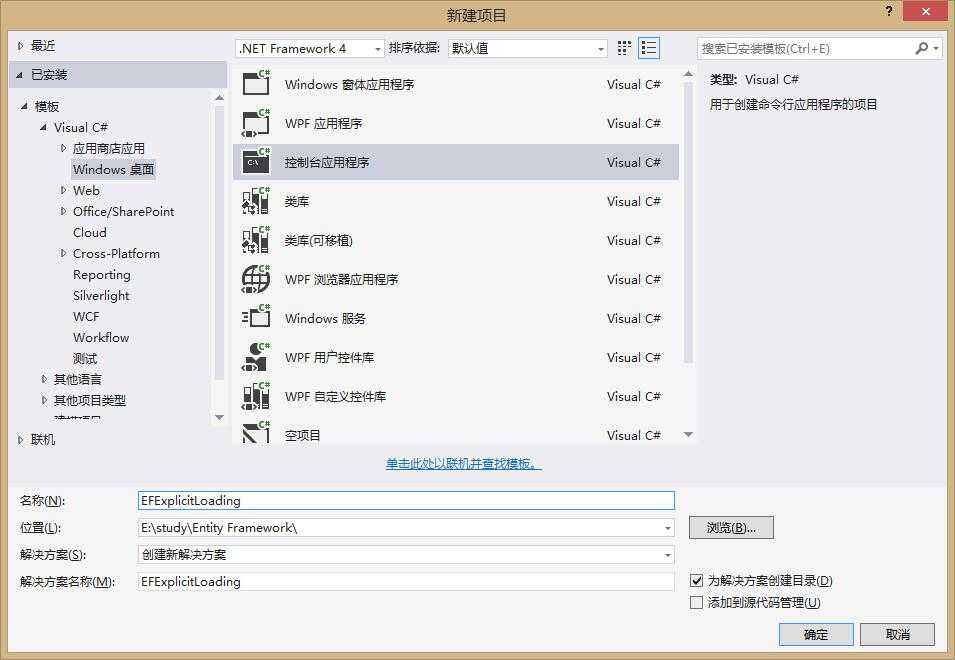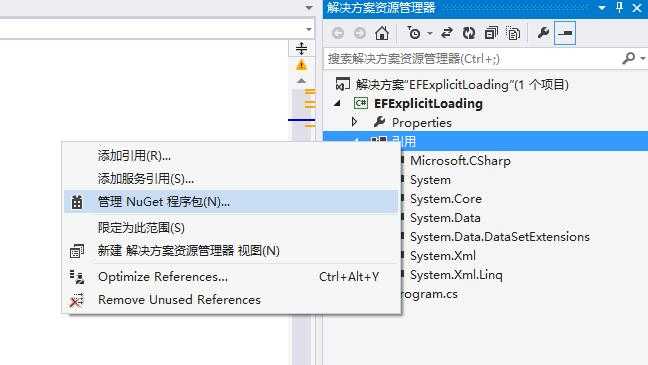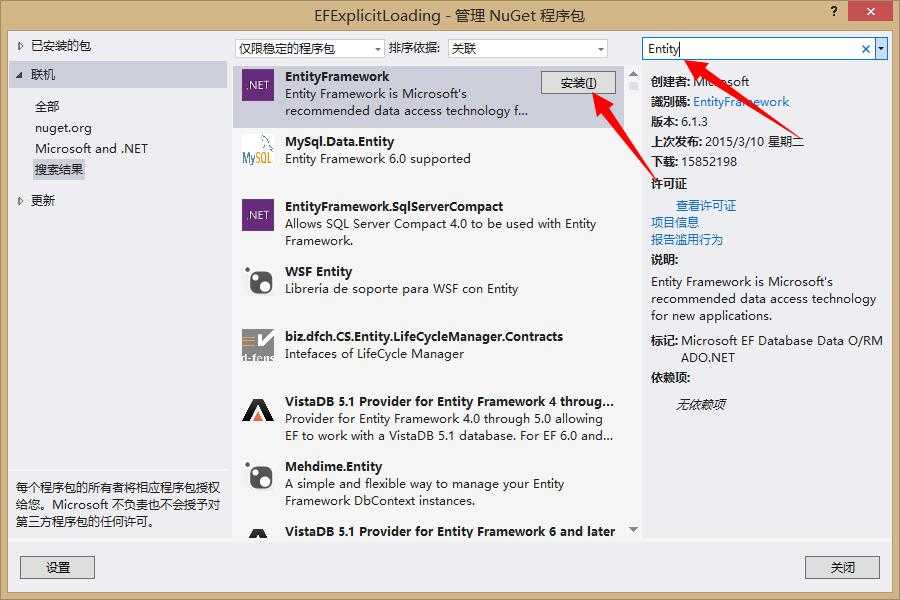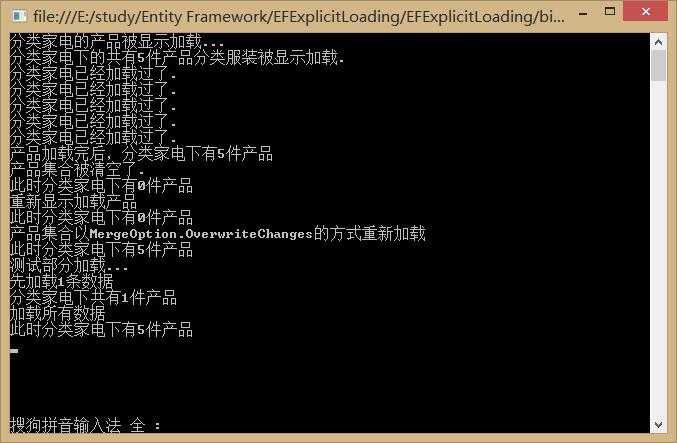标签:
在使用Entity Framework加载关联实体时,可以有三种方式:
1.懒加载(lazy Loading);
2.贪婪加载(eager loading);
3.显示加载(explicit loading)。
EF默认使用的是懒加载(lazy Loading)。一切由EF自动处理。
这种方式会导致应用程序多次连接数据库,这种情况推荐在数据量较大的情况下使用。当我们需要加载数据较少时,一次性全部加载数据会相对更高效。
我们来看看EF的显示加载(explicit loading)如何让我们完全掌控数据的加载(非自动化)。
这里我们使用Code First模式。
数据表:商品表,商品分类表,品牌表
Step1:新建控制台应用程序,添加EF6引用(可以使用NuGet获取)



Step2:创建三个实体对象:Product、Category 、Brand
Product实体类:
1 using System; 2 using System.Collections.Generic; 3 using System.Linq; 4 using System.Text; 5 6 namespace EFExplicitLoading.Models { 7 public class Product { 8 public int ProductId { get; set; } 9 public String Title { get; set; } 10 public int CategoryId { get; set; } 11 12 public virtual Category Category { get; set; } 13 14 public virtual Brand Brand { get; set; } 15 16 } 17 }
Category实体类:
1 using System; 2 using System.Collections.Generic; 3 using System.Linq; 4 using System.Text; 5 6 namespace EFExplicitLoading.Models { 7 public class Category { 8 9 public Category() { 10 Products = new HashSet<Product>(); 11 } 12 13 public int CategoryId { get; set; } 14 public String Name { get; set; } 15 16 public virtual ICollection<Product> Products { get; set; } 17 } 18 }
Brand实体类:
1 using System; 2 using System.Collections.Generic; 3 using System.Linq; 4 using System.Text; 5 6 namespace EFExplicitLoading.Models { 7 public class Brand { 8 9 public Brand() { 10 Products = new HashSet<Product>(); 11 } 12 13 public int BrandId { get; set; } 14 15 public String Name { get; set; } 16 17 public virtual ICollection<Product> Products { get; set; } 18 } 19 }
Step3:创建派生自DbContext的类(ExplicitContext)
1 using System.Data.Entity; 2 using EFExplicitLoading.Models; 3 4 namespace EFExplicitLoading { 5 6 public class ExplicitContext : DbContext { 7 public ExplicitContext() 8 : base("ExplicitConnectionString") { 9 } 10 11 public DbSet<Product> Products { get; set; } 12 13 public DbSet<Category> Categories { get; set; } 14 15 public DbSet<Brand> Brands { get; set; } 16 17 protected override void OnModelCreating(DbModelBuilder modelBuilder) { 18 modelBuilder.Entity<Product>().ToTable("Product"); 19 modelBuilder.Entity<Brand>().ToTable("Brand"); 20 modelBuilder.Entity<Category>().ToTable("Category"); 21 } 22 } 23 24 }
Step4:在App.config中添加connectionStrings节点
1 <connectionStrings> 2 <add name="ExplicitConnectionString" connectionString="Data Source=.;Initial Catalog=EFExplicit;Integrated Security=True;MultipleActiveResultSets=True" providerName="System.Data.SqlClient" /> 3 </connectionStrings>
准备工作已就绪,当我们使用ExplicitContext类时,EF会根据实体自动创建数据库和表
下面回到控制台入口函数处:
Step5:添加测试数据
1 2 using (var context = new ExplicitContext()) { 3 //先清空数据 4 context.Database.ExecuteSqlCommand("delete from product"); 5 context.Database.ExecuteSqlCommand("delete from brand"); 6 context.Database.ExecuteSqlCommand("delete from category"); 7 8 var category1 = new Category {Name = "服装"}; 9 var category2 = new Category {Name = "家电"}; 10 var brand1 = new Brand {Name = "品牌1"}; 11 var brand2 = new Brand {Name = "品牌2"}; 12 13 context.Products.Add(new Product {Brand = brand1, Category = category1, Title = "产品1"}); 14 context.Products.Add(new Product {Brand = brand1, Category = category2, Title = "产品2"}); 15 context.Products.Add(new Product {Brand = brand1, Category = category2, Title = "产品3"}); 16 context.Products.Add(new Product {Brand = brand2, Category = category2, Title = "产品4"}); 17 context.Products.Add(new Product {Brand = brand2, Category = category2, Title = "产品5"}); 18 context.Products.Add(new Product {Brand = brand2, Category = category2, Title = "产品6"}); 19 context.SaveChanges(); 20 }
Step6:开始测试explicit loading
1 using (var context = new ExplicitContext()) { 2 //禁用懒加载 3 context.Configuration.LazyLoadingEnabled = false; 4 5 var category = context.Categories.First(c => c.Name == "家电"); 6 7 //判断分类关联的产品是否已经被加载 8 if (!context.Entry(category).Collection(x => x.Products).IsLoaded) { 9 context.Entry(category).Collection(x => x.Products).Load(); 10 Console.WriteLine("分类{0}的产品被显示加载...", category.Name); 11 } 12 13 Console.Write("分类{0}下的共有{1}件产品", category.Name, category.Products.Count()); 14 15 foreach (var product in context.Products) { 16 if (!context.Entry(product).Reference(x => x.Category).IsLoaded) { 17 context.Entry(product).Reference(x => x.Category).Load(); 18 Console.WriteLine("分类{0}被显示加载.", product.Category.Name); 19 } 20 else { 21 Console.WriteLine("分类{0}已经加载过了.", product.Category.Name); 22 } 23 } 24 25 //重新使用category计算 产品数量 26 Console.WriteLine("产品加载完后,分类{0}下有{1}件产品", category.Name, category.Products.Count()); 27 28 category.Products.Clear(); 29 Console.WriteLine("产品集合被清空了."); 30 Console.WriteLine("此时分类{0}下有{1}件产品", category.Name, category.Products.Count()); 31 32 33 context.Entry(category).Collection(x => x.Products).Load(); 34 Console.WriteLine("重新显示加载产品"); 35 Console.WriteLine("此时分类{0}下有{1}件产品", category.Name, category.Products.Count()); 36 37 //使用ObjectContext刷新实体 38 var objectContext = ((IObjectContextAdapter) context).ObjectContext; 39 var objectSet = objectContext.CreateObjectSet<Product>(); 40 objectSet.MergeOption = MergeOption.OverwriteChanges; 41 objectSet.Load(); 42 //MergeOption.AppendOnly 43 //MergeOption.OverwriteChanges 44 //MergeOption.NoTracking 45 //MergeOption.PreserveChanges 46 47 48 Console.WriteLine("产品集合以MergeOption.OverwriteChanges的方式重新加载"); 49 Console.WriteLine("此时分类{0}下有{1}件产品", category.Name, category.Products.Count()); 50 } 51 52 53 Console.WriteLine("测试部分加载..."); 54 //测试部分加载,然后加载所有 55 using (var context = new ExplicitContext()) { 56 //禁用懒加载 57 context.Configuration.LazyLoadingEnabled = false; 58 var category = context.Categories.First(c => c.Name == "家电"); 59 //先加载1条数据 60 Console.WriteLine("先加载1条数据"); 61 context.Entry(category).Collection(x => x.Products).Query().Take(1).Load(); 62 Console.WriteLine("分类{0}下共有{1}件产品", category.Name, category.Products.Count()); 63 64 //加载所有 65 context.Entry(category).Collection(x => x.Products).Load(); 66 Console.WriteLine("加载所有数据"); 67 68 Console.WriteLine("此时分类{0}下有{1}件产品", category.Name, category.Products.Count()); 69 } 70 71 Console.ReadKey();

要想测试我们的explict loading,必须先禁用懒加载,有2种方式可以禁用懒加载:
1.设置Context.Configuration.LazyLoadingEnabled的值为false 或
2.移除每一个实体类中的关联实体属性(导航属性)的virtual访问修饰符,这种方法可以更精确控制懒加载,即只禁用移除virtual修饰符实体的懒加载
接下来,我们利用EF获取一条Name为家电的分类实体数据,由于Category与Product是一对多的关系,此时我们可以使用IsLoaded属性来测试此分类下的Products集合是否被加载
context.Entry(category).Collection(x => x.Products).IsLoaded
若没有加载,我们使用Load方法来加载关联的Products,在接下来的foreach遍历中,我们可以看到,Category关联的Product已经全部被加载完毕
PS:当使用Take(n)方法Load数据时,IsLoaded属性依然为False,因为只有当关联的所有数据加载完,IsLoaded才为true
这里Entity Framework使用称为"关系修复"的技术(relationship fixup),即当我们单独加载关联实体的时候(Product),这些数据会自动挂载到已经载入的实体(Category),但这种关系修复并不是总是会生效,比如在多对多的关系中就不会这样处理。
然后我们打印出来Category中有多少Product,之后使用Clear()方法清空category对象的关联集合Products。
Clear方法会移除Category和Product的关联关系,但Product集合数据并没有删除,依然存在上下文的内存中,只是它不再与Category关联。
后面我们又重新使用Load加载Product但category.Products.Count()的值依然为0。这正好说明Clear方法的本质。
这是因为Load默认使用MergeOption.AppendOnly的方式加载数据,找不到Product实例了(被Clear了)。然后我们使用MergeOption.OverwriteChanges的方式才将数据重新关联
MergeOption枚举共有4个选项
1.MergeOption.AppendOnly
在现有的关系基础上合并
2.MergeOption.OverwriteChanges
OverwriteChanges模式,会从数据库中更新当前上下文实例的值(使用同一个实体对象的实例,如category)。
当你想要恢复实体在上下文的改变,从数据库刷新实体时,使用这个模式就非常有用。
3.MergeOption.NoTracking
无追踪模式不会跟踪对象的变化,也不会意识到对象已经被加载到当前上下文
NoTracking可以应用到一个实体的导航属性(关联实体属性),但这个实体也必须使用NoTracking
反过来,NoTracking应用到某个实体时,这个实体的导航属性会忽略默认的AppendOnly模式而使用NoTracking模式
4.MergeOption.PreserveChanges
PreserveChanges选项本质上与OverwriteChanges选项相反,
PreserveChanges模式会更新查询结果集(若数据库中有变化),但不会更新在当前上下文内存中的值
PS: 也许你已经注意到,这里我们使用了ObjectContext对象,而不是context对象,这是因为DbContext不能直接使用MergeOption类型,所以必须使用ObjectContext对象
在任何时候,关联实体集合的数量被限制时,使用Load方法,会有助于我们提升程序的性能,比如加载一个Category中的5条Product。
在少量场景中,我们需要整个关联集合时,也可以使用Load
PS:当一个实体在Added(添加)、Deleted(删除)、Detected(分离)状态时,Load方法无法使用。
关于Entity Framework性能提升的方法还有很多,当然,我们必须根据自己的项目实际情况来做优化。不同的应用场景,选择不同的优化方案
示例代码:点此下载
Code First Entity Framework 6化被动为主动之explicit loading模式实战分析( 附源码)
标签:
原文地址:http://www.cnblogs.com/jayshsoft/p/entity-framework-explicit-loading.html